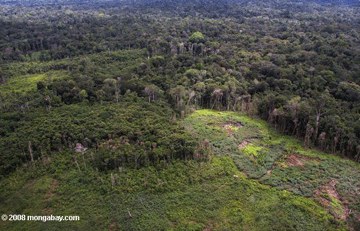Regrowing the Amazon rainforest will require help from bats and birds
Regrowing the Amazon rainforest will require help from bats and birds
mongabay.com
September 15, 2008
|
|
As large tracts of Amazon rainforest are degraded by industrial logging and cleared for cattle pasture and agriculture, other deforested areas are abandoned and being reclaimed by forest. Understanding this recolonization of degraded forest lands by pioneer species will critical to efforts to rehabilitate restore forests around the world.
A new study, published in the open-access journal Tropical Conservation Science, looks at the process by examining the 13 most common pioneer tree species that make up early successional forests in the Central Amazon.
Tony V. Bentos and colleagues found that the pioneer community “showed a variety of phenological patterns but as a whole tended to be characterized by annual flowering and fruiting, either continuously or seasonally.” They suggest that those species with continuous reproduction, starting at small diameters, may produce the most rapid cover; that those dispersed by bats and birds are likely to be spread more widely than those dispersed by primates or terrestrial mammals; and that a mix of bird- and bat-dispersed species is likely to facilitate recruitment of mature forest species and will provide a highly diverse seed rain into secondary forest.

During the 1990s secondary forests replaced one-sixth of all tropical primary forests that were felled during that decade, according to U.N. estimates. |
The research is significant given the global-scale transition from large extents of intact primary forest towards human-dominated landscapes characterized by a matrix of agricultural land and secondary vegetation. Because this anthropogenic matrix is dominated by pioneer species, understanding the traits of these species may help both project the future nature of forests and facilitate restoration of ecosystems.
“In this landscape, pioneer tree species will play three quintessential functions,” the authors explain.
“First, as the critical first elements in the colonization of clearcuts and abandoned agriculture, they determine, together with landscape history, the rates of change and trajectories of secondary successions.”
“Second, during succession, pioneer trees play critical community and ecosystem functions—providing resources for pollinators and seed dispersers, building soil structure, recycling nutrients, and accumulating carbon stocks. Third, the future of fragments of mature forest appears to be increasingly dependent on the quality of the matrix or surrounding secondary vegetation,” they continue.
“In this context, pioneer trees and their life-history traits, especially reproductive characteristics, become tools in the hands of land managers and conservationists. For example, it is now clearly established that the ability of Vismia species to spread vegetatively following fire in Amazon pastures changes the course of woody plant succession after ranches are abandoned.”
The authors of the paper are Tony V. Bentos and Rita C. G. Mesquita of the Smithsonian Tropical Research Institute and G. Bruce Williamson of the Biological Dynamics of Forest Fragments Project at Brazil’s National Institute for Research in the Amazon (INPA).
Tony V. Bentos, Rita C. G. Mesquita, G. Bruce Williamson. Reproductive Phenology of Central Amazon Pioneer Trees. Tropical Conservation Science Vol. 1(3):186-203, September 2008